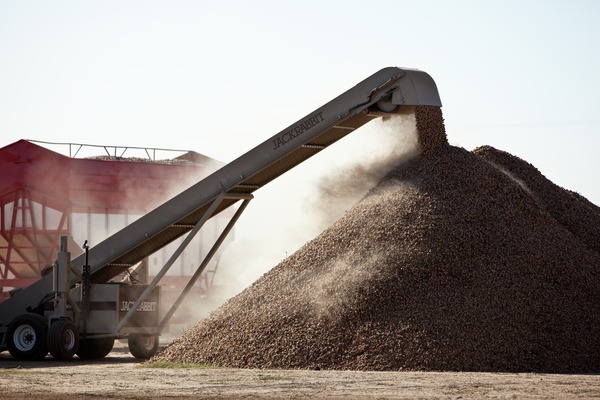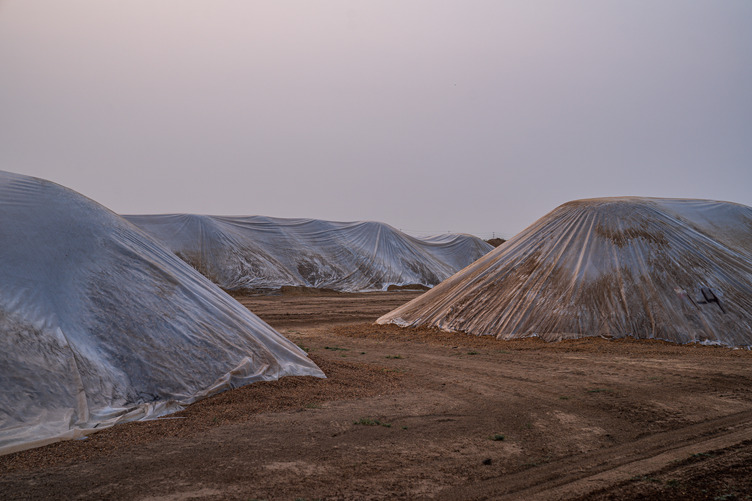
Larger almond harvests mean many huller-sheller facilities will need to build stockpiles until nuts can be processed.
Storing harvested nuts in stockpiles until they can be hulled and processed requires careful management on the part of growers and processors to preserve nut quality and avoid food safety issues.
Tim Birmingham, director of quality assurance and industry services for Almond Board of California, said increasing harvest volumes mean processing can take months after the last loads of nuts are delivered.
“Early in the harvest season, they can keep up with incoming nuts, but stockpiling is more common, and they could be processing nuts until the end of the year,” Birmingham said.
The adage ‘quality in, quality out’ applies with stockpiles.
To prevent mold or other quality issues from invading stockpiles, the grower has the responsibility of delivering nuts that can be safely stored for months.
“A big part of that is delivering nuts with less than 6% moisture in kernels or less than 12% moisture in hulls,” Birmingham said.
The work to deliver quality nuts begins prior to harvest. Guidelines for Good Agricultural Practices state that orchard floors should be dry, hard and clean to not only reduce dust, but to ensure the harvest won’t be contaminated. Smoothing floors and removing as much orchard debris as possible along with scouting the floors for any deceased wildlife is advised prior to start of harvest.
Birmingham also recommends watching the weather forecast. Rain during harvest can increase risk of mold growth and concealed damage in almonds.
Nuts will fare better if left on the tree until threat of rain has passed. But, holding off shaking may not be an option for some growers. If nuts are already on the ground at the time of a rain event, they will need extra time to dry. They should be blown away from the tree trunks and not windrowed. Windrowed nuts that are rained on may need to be conditioned to accelerate drying. Blowing away leaves and other orchard debris from the windrows can help the drying process.
“Give them time to dry. Turn the windrows if necessary to help them dry,” Birmingham said.
If nuts are destined to be stockpiled at the processor, it is important to take samples to know moisture levels, especially if it has rained after the nuts were shaken.
Taking Samples
Taking nut samples from across the orchard floor and along the tree row provides a complete sample of the almonds. There is variability between drying on the orchard floor and in windrows. Sampling should take this variability into account.
Almond Board also recommends taking samples from places in the orchard which are likely to be wetter. Those places include the north side of the canopy next to the tree trunk where moisture can be about 2% higher than other areas. Samples taken from windrows should be chosen from the bottom layers.
The ABC guidelines for almonds to be stockpiled is below 6% moisture for the in-shell kernel, less than 9% for the total in-hull almonds and less than 12% moisture content for the hulls. If moisture levels exceed the percentage for in-shell kernels or hulls, the nuts should not be stockpiled.
Ensuring food safety and quality begins in the orchard. Even if nuts are not going in a stockpile, they should be adequately dried and picked up from a clean orchard floor.
Nuts exposed to excess moisture in the orchard can develop mold. Certain molds produce aflatoxins, which are health concerns. Molds may live in the soil or they can develop in nuts from navel orangeworm feeding. Maximum allowable levels of aflatoxin contamination have been set by many countries that import California almonds, making it important to ensure early prevention of contamination.

Concealed Damage
Research funded by ABC has resulted in development of best practices for stockpile management to prevent both aflatoxins and minimize the formation of concealed damage, a condition in which off-flavors and off-colors are revealed after roasting.
Exposure to excess moisture at harvest can cause concealed damage in almonds. This quality issue does not become apparent until after the nuts are heated during processing.
“We saw this at the 2012 harvest which had a lot of rain,” Birmingham said. The moisture remained in nuts, and, after processing, kernels were discolored and had an off-flavor.
If nuts are exposed to high moisture levels and nothing is done to expedite drying, concealed damage can occur. In wet conditions, one option is to pick the nuts up off the orchard floor and dry them artificially.
Creating Stockpiles
Almond stockpiles are not common on-farm, but as huller-sheller capacity is reached, they are an option for a grower.
The ideal site would have a slight slope to drain away moisture and a hard surface. The shape and positioning of the stockpile can also control moisture and mold growth. An even, flat top helps prevent pooling of moisture in low spots. Positioning the long side of the stockpile from north to south also helps prevent condensation from forming.
Stockpiles built at a processing facility are covered with tarps, which can protect nuts from contamination by birds or rodents. Use of a tarp requires some attention. For properly dried field-run nuts, black/white or white tarps are recommended, and if the field-run nuts have a moisture level greater than the moisture levels suggested by the guideline, the stockpile can be occasionally uncovered to avoid condensation buildup.
Moisture is also a significant factor in the growth of mold Aspergillus that produces aflatoxins. Moisture in the stockpile, coupled with hot weather temperatures, can trigger growth of this mold. Monitoring the moisture in the nuts or humidity in the stockpile and adjusting conditions can limit fluctuation of the moisture in the stockpile. Removing tarps during the day and covering during the night is recommended, especially for the stockpiles with higher moistures from field runs.
ABC has a chart to calculate the moisture content of a stockpile based on relative humidity, which can be found at almonds.com/sites/default/files/2020-03/grower_stockpile_management_best_practices_from_abc_2014%5B1%5D.pdf.










